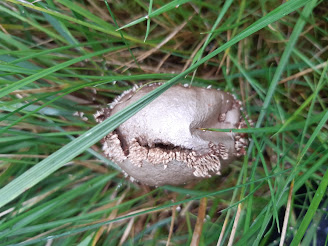BiologyAlive
Sunday, 20 September 2020
'Smooth, shiny, wavy, rich chestnut brown..' Bay polypore
Sunday, 23 August 2020
'Prickly Wolf's Fart' Fungus; Lycoperdon echinatum or Spiny Puffball
Walking through a bracken maze on the hills above Ullswater, I was relieved to spy a stream and the promise of a way out. The bracken thinned as I approached, and gave way to long grass underneath my feet. Something metallic looking in the grass caught my eye. It looked foreign in the environment, and my first thought, when I clocked it's rounded, slightly flattened shape, was that it was a child's purse that had been dropped. Closer inspection revealed that the coppery-coloured mass was not rigid but soft and easily dented, and the projections that I had taken to be jewels were, infact, spines. When I pressed it, it let out a jet of darkly coloured spores from the underside. I knew what it was; a puffball.
I did not immediately recognise it as a spiny puffball, because as you can see from the photo, most of the spines are missing! However, this is something that happens with age, and this puffball was certainly mature enough to puff.
The genus Lycoperdon means 'Wolf's fart', but I can't attest to it's smell, or that of a wolf's to be fair! Echinatum means prickly in Latin. Maybe it does resemble a sea-urchin when it is younger and covered in spines. It tends to grow in alkaline conditions and beech woods, and is a rare find in the UK!
Sunday, 2 August 2020
Dragonfly nymph skin (Exuvia)
Damselfly and dragonfly start life in the water and grow through a large number of nymph stages. Depending on the species, and also environmental factors such as the temperature, they can stay up to four years in the water! Imagine my surprise when I was clearing out the blanket weed and came across this:
Sunday, 20 October 2019
Fungi as part of climax community in psammosere
Sunday, 6 October 2019
Devil's Urn, Otherwise known as Urnula craterium
This was a good find. Had to go a bit off-piste in Burleigh Woods. But what a reward tramping through the brambles. This is a monster fungus. About 10 cm across and a really deep cup. It's brown and a bit scraggy on the outside. On the inside, which is spore producing, it's black and smooth.
Saturday, 5 October 2019
Fairy Toadstool Amanita muscaria or Fly Agaric
The Fly Agaric needs little introduction. It is the toadstool that graces all books about fairies!
It's not so common in real life, and I only ever find them singly. It is widespread and found mostly in birch woodlands .
How do you like your beefsteak (fungus)?
This was an important clue in it's identification. I looked up the scientific name, Fistulina hepatica. Hepatica means liver. Young fungi look more like liver before maturing into the instantly recognisable beefsteak.
To check my theory out, I went up to Jubilee woods where I knew there was a tree with beefsteak fungi. Sure enough, it didn't disappoint. It is amazing how very much like a beefsteak they look. These ones were a bit old, however, and had lost their pink raw meat colour. One had even fallen on the floor.
But further down the same fallen tree, I found the evidence I was looking for: a small, pink amorphous blob of the hepatica type. So this confirmed the ID of my friend's initial find.





















